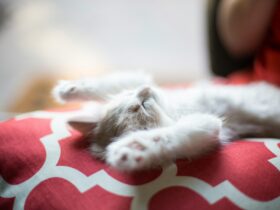Blog: How to Reduce Cat Dander & Allergies | Just How Often Should I Really Be Feeding My Cat?
Introduction
Feeding your cat the right amount of food at the right times is crucial for maintaining their health and well-being. However, determining how often to feed your cat can be challenging, especially with varying advice from different sources. This blog will explore the best feeding practices for cats, how these practices impact their health, and how they can influence the production of dander, a common allergen. By understanding the link between diet and dander, you can better manage allergies in your home while ensuring your cat stays healthy and happy.
The Basics of Feeding Cats
1. Understanding Your Cat’s Nutritional Needs
- Obligate Carnivores: Cats are obligate carnivores, meaning their diet must consist primarily of meat. They require specific nutrients like taurine, arachidonic acid, and vitamin A, which are found in animal tissues. Their diet should be rich in protein, with moderate fat levels and minimal carbohydrates.
- Life Stage Considerations: The amount and frequency of feeding can depend on your cat’s life stage. Kittens, adult cats, and senior cats have different nutritional needs, and their feeding schedules should reflect these differences.
2. Types of Cat Food
- Wet Food: Contains higher moisture content, which is beneficial for hydration and urinary tract health. Wet food can also help maintain a healthy weight, as it tends to be lower in calories than dry food.
- Dry Food: While more convenient and longer-lasting, dry food typically contains more carbohydrates and less moisture. It’s essential to ensure your cat has access to plenty of water if their diet includes dry food.
How Often Should You Feed Your Cat?
1. Feeding Schedules Based on Age
- Kittens (0-6 months): Kittens have higher energy needs and should be fed more frequently. A typical schedule might include 3-4 small meals per day to support their rapid growth and development.
- Adolescent Cats (6 months – 1 year): As your kitten matures, you can reduce the feeding frequency to 2-3 times per day. This helps maintain their energy levels while preventing overeating.
- Adult Cats (1-7 years): Most adult cats thrive on 2 meals per day. This schedule aligns with their natural hunting instincts, where they would typically eat smaller, more frequent meals in the wild.
- Senior Cats (7+ years): Older cats may benefit from smaller, more frequent meals to accommodate changes in metabolism and digestion. You might consider feeding them 2-3 times a day.
2. Free Feeding vs. Scheduled Meals
- Free Feeding: Leaving food out all day allows your cat to eat whenever they’re hungry. While this is convenient, it can lead to overeating, obesity, and poor nutrition, especially if you’re using dry food.
- Scheduled Meals: Feeding your cat at specific times each day helps regulate their appetite, supports a healthy weight, and makes it easier to monitor their food intake. This method is generally recommended by veterinarians.
Impact of Feeding Frequency on Cat Health
1. Weight Management
- Obesity Risks: Overfeeding or free feeding can lead to obesity, which is associated with various health problems, including diabetes, arthritis, and heart disease. Feeding your cat on a schedule helps control portions and prevents weight gain.
- Maintaining a Healthy Weight: Regularly scheduled meals help you monitor your cat’s weight more effectively. Adjusting portions based on your cat’s weight and activity level can prevent obesity and its associated risks.
2. Digestive Health
- Preventing Gastrointestinal Issues: Cats are more likely to experience gastrointestinal problems, such as vomiting or diarrhea, if they eat too much at once or too infrequently. Smaller, more frequent meals can support better digestion and reduce the risk of these issues.
- Hydration and Urinary Health: Cats have a low thirst drive, so feeding them wet food or encouraging them to eat small, regular meals can help them stay hydrated and prevent urinary tract problems.
The Connection Between Diet and Cat Dander
1. Role of Nutrition in Skin and Coat Health
- Essential Nutrients: A balanced diet rich in essential nutrients like omega-3 and omega-6 fatty acids is vital for maintaining healthy skin and a shiny coat. Good skin health reduces dander production, which is a common allergen for people.
- Impact of Overfeeding: Overfeeding can lead to obesity, which can strain your cat’s skin, making it dry and flaky. Dry skin increases dander production, exacerbating allergies.
2. Importance of Proper Feeding Schedules
- Regulating Skin Oils: Regular, balanced meals help regulate your cat’s skin oils, which are crucial for preventing dry skin and reducing dander. A proper feeding schedule ensures your cat receives the right amount of nutrients at the right times, supporting overall skin health.
- Preventing Food Allergies: Some cats develop food allergies, which can cause skin problems and increase dander production. Feeding your cat a diet free from common allergens and maintaining a consistent feeding routine can help manage these issues.
Tips for Reducing Cat Dander and Managing Allergies
1. Grooming and Bathing
- Regular Brushing: Regularly brushing your cat removes loose fur and dander, reducing the amount that ends up in your home. It also helps distribute skin oils, keeping your cat’s coat healthy.
- Occasional Bathing: Bathing your cat with a dander-reducing shampoo can help manage dander levels. However, over-bathing can dry out the skin, so it’s important to strike a balance.
2. Maintaining a Clean Living Environment
- Air Purifiers: Using an air purifier can help reduce airborne dander and allergens, making your home more comfortable for allergy sufferers.
- Cleaning Routines: Regularly cleaning your home, especially areas where your cat spends time, can help minimize dander buildup. Wash your cat’s bedding frequently to reduce allergens.
3. Dietary Supplements
- Omega-3 Fatty Acids: Adding omega-3 fatty acids to your cat’s diet can improve skin and coat health, reducing dander production. These supplements can be found in fish oil or specialized cat foods.
- Probiotics: Probiotics support gut health, which can positively impact your cat’s skin and overall well-being. A healthy gut can reduce the likelihood of skin issues that contribute to dander.
Conclusion
Feeding your cat the right amount of food at the right times is essential for their overall health, including their skin and coat condition. By understanding your cat’s nutritional needs and establishing a proper feeding schedule, you can help manage their weight, support their digestive health, and reduce the production of dander. This not only keeps your cat happy and healthy but also makes your home a more comfortable place for everyone, especially those with allergies.











Leave a Reply